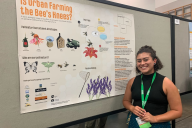You have /5 articles left.
Sign up for a free account or log in.
d67b.jpg?itok=dvInT1ED)
diignat/iStock/Getty Images Plus
Some weeks back, a first-year student walked into one of our offices to talk about how to best use his time at Bowdoin College. He was inspired by a show featuring robots that he watched as a child in Ghana and thought he’d likely follow a path involving math and computer science. But then he paused and said, I’m also considering a dance course. Can I just make room for interesting things?
The pressure on today’s college students to perform, to follow a clear pre-professional path and to “win” in a world where the fortunes of the privileged and the less privileged are increasingly divergent, is real. Many students come to college with the idea that the best way to achieve their goals is to pursue subjects with the most linear possible applicability to the world of work—often thought to be the STEM disciplines. As an extension of that logic, they have absorbed an increasingly common misconception that when they incorporate courses in the arts, humanities and social sciences into their educations they are passing up opportunities to improve their chances for a meaningful career.
Sitting with students wrestling with these anxieties feels poignant and also frustrating. We want to recenter the human being in this conversation. We want to celebrate their passion for ideas and subject matter because these things lead to genuine learning. We want students to know that a liberal arts education that includes deep engagement with the humanities prepares its beneficiaries to face the profound challenges and joys that life will confront them with, not simply to function as employees. We want them to understand that humanities are not something students should wonder if they can make room for, but a central ingredient of an education that will prepare them to be interdisciplinary thinkers poised to solve the most complex problems of our times. Challenges such as climate change and the complexities of artificial intelligence are at once technical, social and cultural, and will call upon every dimension of their learning—an advantage in the job search (and a fact we’ll address at more length in a minute).
Our students are fascinating and multifaceted—they are computer scientists and dancers, future policymakers and linguists. When did we start making them feel they have to choose to be only one part of themselves and, just as bad, plant the idea that a career calls upon only one part of you?
Some of this has to do, no doubt, with what students are hearing from families, peers, and the larger media environment in which we all live. The popular imagination would hold that highly-specialized “practical” degrees are the pathway to riches, while humanities majors are doomed to a life of poverty. This simplistic narrative runs counter to the evidence—recent studies have shown, for instance, that people graduating with a philosophy B.A. often earn as much as or more than those with degrees in STEM fields like biology and chemistry, and more than those with “pre-business” degrees in fields like accounting and marketing. Meanwhile, our alumni are extraordinarily successful in all walks of life, no matter what their majors were while they were here on campus.
So, if evidence demonstrates that a liberal arts education contributes significantly to career success, what accounts for the durability of the myth that it doesn’t? We think the myth finds much of its potency in the seeming mismatch between what employers say they want and what students and faculty often describe as the point of a course. Our course descriptions speak of the very real joys of introducing students to the languages and literatures of other parts of the world, of opening their eyes to the complexity of historical moments, of enabling them to understand the cultural productions of times and places far, far distant from our campus. One of the most oft-quoted texts associated with our institution is a piece known as “The Offer of the College,” written by one of our past presidents, which promises our students that they will be able to “lose themselves in generous enthusiasms.” Meanwhile, surveys consistently show that employers of all sorts want to hire college graduates capable of efficiently taking on workaday—but obviously crucial—tasks: they seek new employees capable of “problem solving” and of “working in groups,” who are adept at both “verbal communication” and “written expression.”
We had another conversation recently with a student completing an honors thesis in a language department. The student had spent several months using that language to conduct interviews and do primary research investigating the sophisticated strategies a local environmental advocacy group had used to stay relevant and effective without provoking its government so much that it would be shut down. We then spent a part of the senior seminar with that student, twelve of his classmates and several faculty members articulating the specific skills gained in the process of attaining fluency in another language. The students were brilliant at describing the ways in which speaking in a second language requires you to select each word carefully for specific nuance, and work hard to read nonverbal signals in high-stakes settings—exactly the skills that have propelled many people to roles leading influential organizations. But we have not taught students to value these. On his way out the door from that session, the author of that honors thesis said it was the first time he’d sat down to articulate the value of his chosen major and coursework and that the experience afforded him new confidence in presenting himself for professional opportunities.
The disconnect between what students gain from a liberal arts education and what employers want from their new employees is not as vast as it seems; in fact, the disconnect may be an illusion. In focus groups with employers who frequently hire from liberal arts colleges, we asked what was missing from commonly cited lists of skills employers desire, and they built on the lists with items such as “going deep to get the answer and thinking creatively about where to get information” and “wrestling with conflicting information and values.” Many said they’d seen over and over in their careers that college graduates can acquire the technical skills on the job, but it’s the recent hire who thinks creatively and expresses themselves persuasively who is making a difference at the organization five years later. Those skills are taught in the liberal arts curriculum in abundance.
What we—leaders in academic institutions—often fail to do is help students translate. Academic language can obfuscate—sometimes it seems designed to do so on purpose—and we take pride in the particularized vocabularies that go with our specialties. In any field, what sounds like “jargon” to outsiders can be understood as precise technical terminology by members of a community of skilled practitioners. We need to keep in mind that students will travel between those two worlds—between scholars and classmates, employers and co-workers. It is incumbent upon us to prepare our students to navigate that transition—to be prepared to describe their educational experiences and achievements to a broader world in language that world can comprehend. Without being taught to make that translation— without an exercise like the one we conducted with the language students—students speaking with potential employers may be unable to fully display the tremendous capabilities they possess.
In other words, this isn’t a matter of transforming our courses into something they’re not, or that they should not be. An Italian literature course needn’t teach coding (though it can, and that’s a fascinating conversation about the integration of the humanities and STEM in itself). Nor is it a matter of dropping the topics that are accused of being “esoteric” and replacing them with something “pragmatic.” Rather, it’s a matter of making visible to students the broadly applicable dimensions of the often highly specialized studies they’re engaged in—of helping them recognize when an assignment or activity is both worthwhile in scholarly terms and can be understood as being an exercise in the kinds of things one will be expected to do in one’s working life. And it’s a matter of helping students not only see those moments of applicability, but of giving them the language that will enable them to convey to potential future employers the fact that they’ve acquired those skills.
This need not be done in only one class, nor does it need to be done all at once. If students can be equipped with the language that allows them to perceive and describe the “practical” skills they obtain through their coursework, and if they can be given opportunities to practice using that language, they will be exceptionally well-prepared to launch themselves on a successful and personally satisfying career path. They will be able, almost effortlessly, to speak about their research projects as examples of “problem-solving.” They will be ready to describe their experiences with group projects as opportunities that allowed them to master the diplomatic and leadership skills involved in “working as a team.” They will be prepared to discuss their experiences presenting their own academic research in different forms —from the brief abstract of a paper to an oral synopsis to the full project—as the ways that they have mastered the crucial dimensions of “oral and written communication.” And doing this in the context of a rich liberal arts curriculum carries with it an added benefit, in terms of the skills being examined in a job interview: the student is equipped not only with a list of accomplishments, but also with a range of fascinating stories to go along with them—stories of the peoples, places and ideas encountered through the course of their education.



